BSBSUS501 Assessment 2: Develop Workplace Sustainability Policy
VerifiedAdded on 2022/09/07
|17
|3713
|22
Report
AI Summary
This report presents a comprehensive analysis of workplace sustainability policies and procedures, addressing the requirements of the BSBSUS501 unit. The assignment is divided into three parts, with Part A examining current sustainability practices, including life cycle management approaches, energy consumption, water management, paper usage, waste management, and hazardous substances, referencing the Westpac Group as a case study. Part B focuses on developing a new sustainability policy, outlining relevant legislation, policy ownership, purpose, scope, goals, desired outcomes, strategies for reducing toxic materials, sustainability strategies, responsibilities, implementation procedures, and continuous improvement measures. Part C includes activities related to the policy development and implementation. The report explores various aspects of sustainability, such as energy efficiency, waste reduction, and the reduction of carbon footprints, and provides recommendations for policy implementation and continuous improvement within an organization.

BSBSUS501 Develop workplace policy and procedures for
sustainability –
Assessment 2
sustainability –
Assessment 2
Paraphrase This Document
Need a fresh take? Get an instant paraphrase of this document with our AI Paraphraser
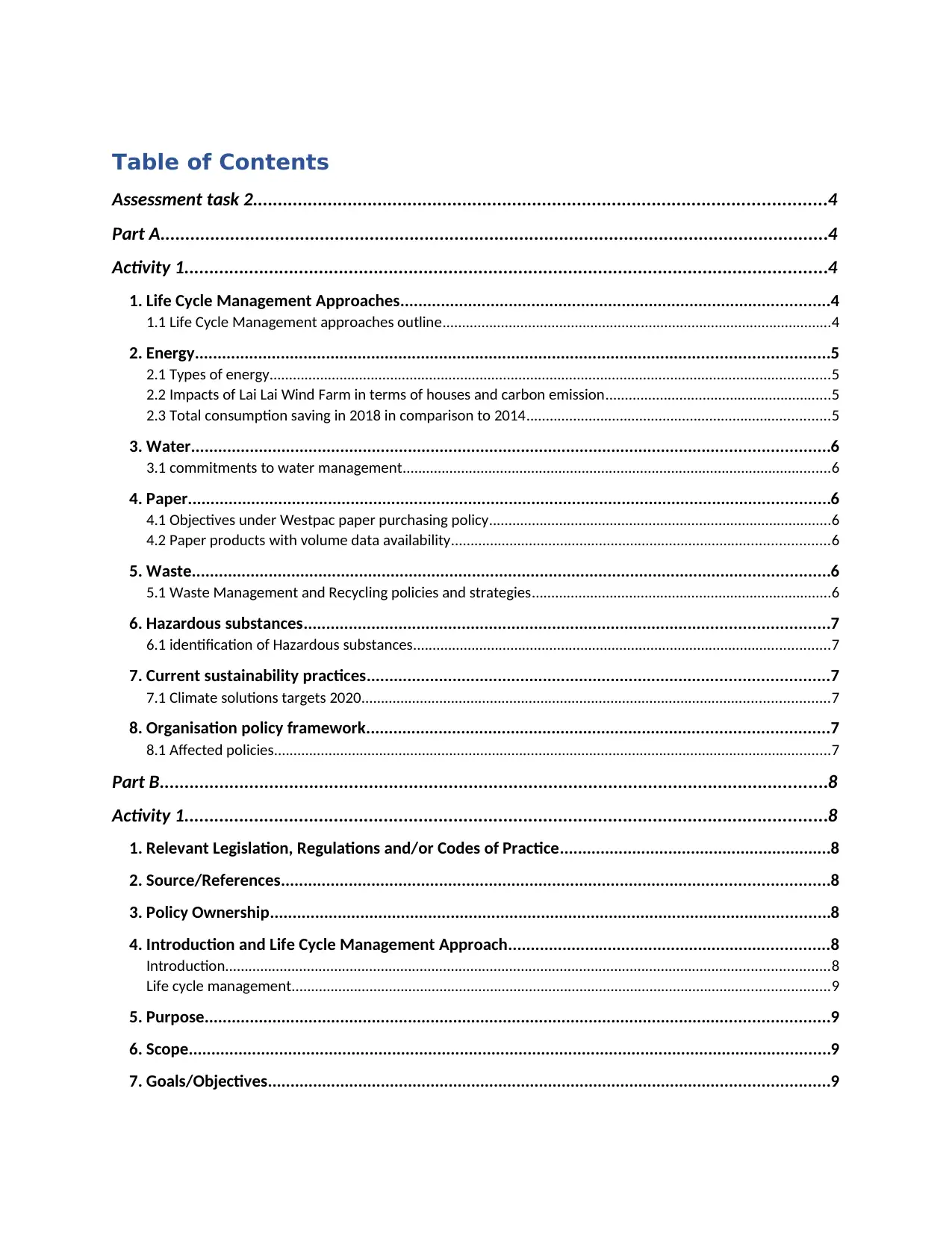
Table of Contents
Assessment task 2...................................................................................................................4
Part A......................................................................................................................................4
Activity 1.................................................................................................................................4
1. Life Cycle Management Approaches...............................................................................................4
1.1 Life Cycle Management approaches outline....................................................................................................4
2. Energy............................................................................................................................................5
2.1 Types of energy................................................................................................................................................5
2.2 Impacts of Lai Lai Wind Farm in terms of houses and carbon emission..........................................................5
2.3 Total consumption saving in 2018 in comparison to 2014..............................................................................5
3. Water.............................................................................................................................................6
3.1 commitments to water management..............................................................................................................6
4. Paper..............................................................................................................................................6
4.1 Objectives under Westpac paper purchasing policy........................................................................................6
4.2 Paper products with volume data availability.................................................................................................6
5. Waste.............................................................................................................................................6
5.1 Waste Management and Recycling policies and strategies.............................................................................6
6. Hazardous substances....................................................................................................................7
6.1 identification of Hazardous substances...........................................................................................................7
7. Current sustainability practices......................................................................................................7
7.1 Climate solutions targets 2020........................................................................................................................7
8. Organisation policy framework......................................................................................................7
8.1 Affected policies...............................................................................................................................................7
Part B......................................................................................................................................8
Activity 1.................................................................................................................................8
1. Relevant Legislation, Regulations and/or Codes of Practice............................................................8
2. Source/References.........................................................................................................................8
3. Policy Ownership............................................................................................................................8
4. Introduction and Life Cycle Management Approach.......................................................................8
Introduction...........................................................................................................................................................8
Life cycle management..........................................................................................................................................9
5. Purpose..........................................................................................................................................9
6. Scope..............................................................................................................................................9
7. Goals/Objectives............................................................................................................................9
Assessment task 2...................................................................................................................4
Part A......................................................................................................................................4
Activity 1.................................................................................................................................4
1. Life Cycle Management Approaches...............................................................................................4
1.1 Life Cycle Management approaches outline....................................................................................................4
2. Energy............................................................................................................................................5
2.1 Types of energy................................................................................................................................................5
2.2 Impacts of Lai Lai Wind Farm in terms of houses and carbon emission..........................................................5
2.3 Total consumption saving in 2018 in comparison to 2014..............................................................................5
3. Water.............................................................................................................................................6
3.1 commitments to water management..............................................................................................................6
4. Paper..............................................................................................................................................6
4.1 Objectives under Westpac paper purchasing policy........................................................................................6
4.2 Paper products with volume data availability.................................................................................................6
5. Waste.............................................................................................................................................6
5.1 Waste Management and Recycling policies and strategies.............................................................................6
6. Hazardous substances....................................................................................................................7
6.1 identification of Hazardous substances...........................................................................................................7
7. Current sustainability practices......................................................................................................7
7.1 Climate solutions targets 2020........................................................................................................................7
8. Organisation policy framework......................................................................................................7
8.1 Affected policies...............................................................................................................................................7
Part B......................................................................................................................................8
Activity 1.................................................................................................................................8
1. Relevant Legislation, Regulations and/or Codes of Practice............................................................8
2. Source/References.........................................................................................................................8
3. Policy Ownership............................................................................................................................8
4. Introduction and Life Cycle Management Approach.......................................................................8
Introduction...........................................................................................................................................................8
Life cycle management..........................................................................................................................................9
5. Purpose..........................................................................................................................................9
6. Scope..............................................................................................................................................9
7. Goals/Objectives............................................................................................................................9

8. Desired Outcomes and Performance Indicators............................................................................10
9. Toxic Material and Hazardous Chemical Use Reduction Strategies...............................................10
10. Sustainability Strategies/ Activities to be undertaken................................................................10
11. Responsibilities...........................................................................................................................10
12. Procedures and Systems for Implementation.............................................................................11
13(a). Monitoring and Record Keeping.............................................................................................11
14. Continuous Improvement of Resource Efficiency........................................................................12
15. Review/Evaluation Process.........................................................................................................12
16. Date of next review....................................................................................................................12
Part C....................................................................................................................................13
Activity 1...............................................................................................................................13
Activity 2...............................................................................................................................14
References:...........................................................................................................................16
9. Toxic Material and Hazardous Chemical Use Reduction Strategies...............................................10
10. Sustainability Strategies/ Activities to be undertaken................................................................10
11. Responsibilities...........................................................................................................................10
12. Procedures and Systems for Implementation.............................................................................11
13(a). Monitoring and Record Keeping.............................................................................................11
14. Continuous Improvement of Resource Efficiency........................................................................12
15. Review/Evaluation Process.........................................................................................................12
16. Date of next review....................................................................................................................12
Part C....................................................................................................................................13
Activity 1...............................................................................................................................13
Activity 2...............................................................................................................................14
References:...........................................................................................................................16
⊘ This is a preview!⊘
Do you want full access?
Subscribe today to unlock all pages.

Trusted by 1+ million students worldwide

Assessment task 2
Part A
Activity 1
1. Life Cycle Management Approaches
1.1 Life Cycle Management approaches outline
Life cycle management approaches under this organization must be based on specific sections
and attributes which can be held responsible for facilitating better outcomes in understanding the
ongoing process. It is the process which is associated with the segmentation process and provides
them with some of the most attractive sections across the business. These segments are the most
profitable across all the other fragments (Lozano, 2015). It will also illustrate liabilities for
performing better expansion possibilities which can be used to justify the growing operational
limits all along the organizational structure.
Life cycle assessment
Life cycle assessment will help in guiding the process by extracting sufficient information
related to the process. Each of the operations that are being carried out regularly are laced to
justify the needs and requirements of related life cycle are sustained under this process. The
entire network of operation that is based on this huge scale interaction supports the company in
terms of its sustainable and futuristic approaches towards the growing carbon emission concerns.
Life cycle costing
Costs are a major determining factor in the overall process of life cycle management. Assessing
the costs can be largely beneficial for understanding the exact potential of various dimensions
and their relative utilization. An understanding of cost sufficiency is also beneficial for
maintaining huge developmental psychology across the entire process structure (Qureshi et al.
2015). A limitation in costing can be considered as an important factor for the usability of non-
sustainable energy sources across the organizations. The entire process is suitably based on their
respective costings and operational costings based on the resources used.
Part A
Activity 1
1. Life Cycle Management Approaches
1.1 Life Cycle Management approaches outline
Life cycle management approaches under this organization must be based on specific sections
and attributes which can be held responsible for facilitating better outcomes in understanding the
ongoing process. It is the process which is associated with the segmentation process and provides
them with some of the most attractive sections across the business. These segments are the most
profitable across all the other fragments (Lozano, 2015). It will also illustrate liabilities for
performing better expansion possibilities which can be used to justify the growing operational
limits all along the organizational structure.
Life cycle assessment
Life cycle assessment will help in guiding the process by extracting sufficient information
related to the process. Each of the operations that are being carried out regularly are laced to
justify the needs and requirements of related life cycle are sustained under this process. The
entire network of operation that is based on this huge scale interaction supports the company in
terms of its sustainable and futuristic approaches towards the growing carbon emission concerns.
Life cycle costing
Costs are a major determining factor in the overall process of life cycle management. Assessing
the costs can be largely beneficial for understanding the exact potential of various dimensions
and their relative utilization. An understanding of cost sufficiency is also beneficial for
maintaining huge developmental psychology across the entire process structure (Qureshi et al.
2015). A limitation in costing can be considered as an important factor for the usability of non-
sustainable energy sources across the organizations. The entire process is suitably based on their
respective costings and operational costings based on the resources used.
Paraphrase This Document
Need a fresh take? Get an instant paraphrase of this document with our AI Paraphraser
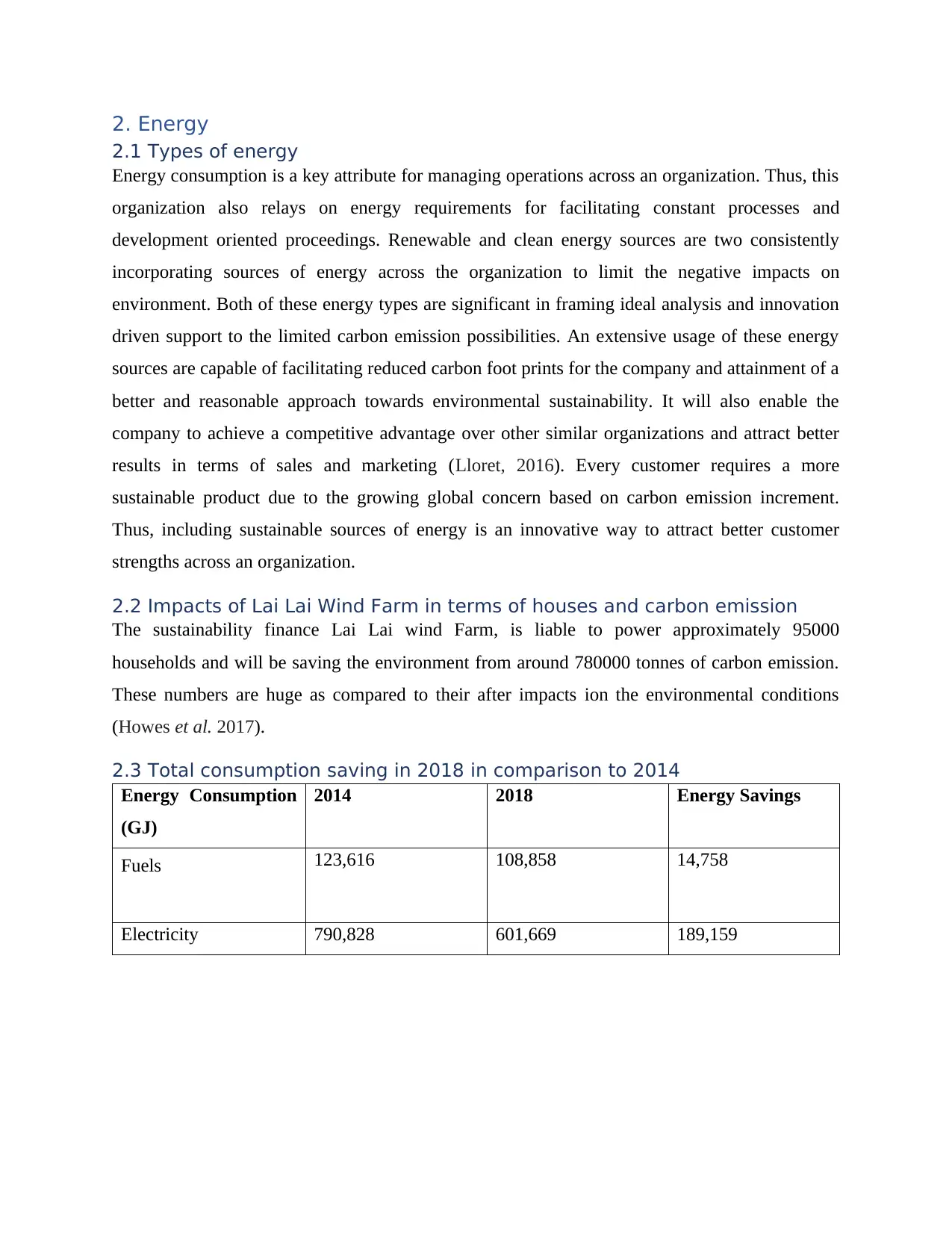
2. Energy
2.1 Types of energy
Energy consumption is a key attribute for managing operations across an organization. Thus, this
organization also relays on energy requirements for facilitating constant processes and
development oriented proceedings. Renewable and clean energy sources are two consistently
incorporating sources of energy across the organization to limit the negative impacts on
environment. Both of these energy types are significant in framing ideal analysis and innovation
driven support to the limited carbon emission possibilities. An extensive usage of these energy
sources are capable of facilitating reduced carbon foot prints for the company and attainment of a
better and reasonable approach towards environmental sustainability. It will also enable the
company to achieve a competitive advantage over other similar organizations and attract better
results in terms of sales and marketing (Lloret, 2016). Every customer requires a more
sustainable product due to the growing global concern based on carbon emission increment.
Thus, including sustainable sources of energy is an innovative way to attract better customer
strengths across an organization.
2.2 Impacts of Lai Lai Wind Farm in terms of houses and carbon emission
The sustainability finance Lai Lai wind Farm, is liable to power approximately 95000
households and will be saving the environment from around 780000 tonnes of carbon emission.
These numbers are huge as compared to their after impacts ion the environmental conditions
(Howes et al. 2017).
2.3 Total consumption saving in 2018 in comparison to 2014
Energy Consumption
(GJ)
2014 2018 Energy Savings
Fuels 123,616 108,858 14,758
Electricity 790,828 601,669 189,159
2.1 Types of energy
Energy consumption is a key attribute for managing operations across an organization. Thus, this
organization also relays on energy requirements for facilitating constant processes and
development oriented proceedings. Renewable and clean energy sources are two consistently
incorporating sources of energy across the organization to limit the negative impacts on
environment. Both of these energy types are significant in framing ideal analysis and innovation
driven support to the limited carbon emission possibilities. An extensive usage of these energy
sources are capable of facilitating reduced carbon foot prints for the company and attainment of a
better and reasonable approach towards environmental sustainability. It will also enable the
company to achieve a competitive advantage over other similar organizations and attract better
results in terms of sales and marketing (Lloret, 2016). Every customer requires a more
sustainable product due to the growing global concern based on carbon emission increment.
Thus, including sustainable sources of energy is an innovative way to attract better customer
strengths across an organization.
2.2 Impacts of Lai Lai Wind Farm in terms of houses and carbon emission
The sustainability finance Lai Lai wind Farm, is liable to power approximately 95000
households and will be saving the environment from around 780000 tonnes of carbon emission.
These numbers are huge as compared to their after impacts ion the environmental conditions
(Howes et al. 2017).
2.3 Total consumption saving in 2018 in comparison to 2014
Energy Consumption
(GJ)
2014 2018 Energy Savings
Fuels 123,616 108,858 14,758
Electricity 790,828 601,669 189,159
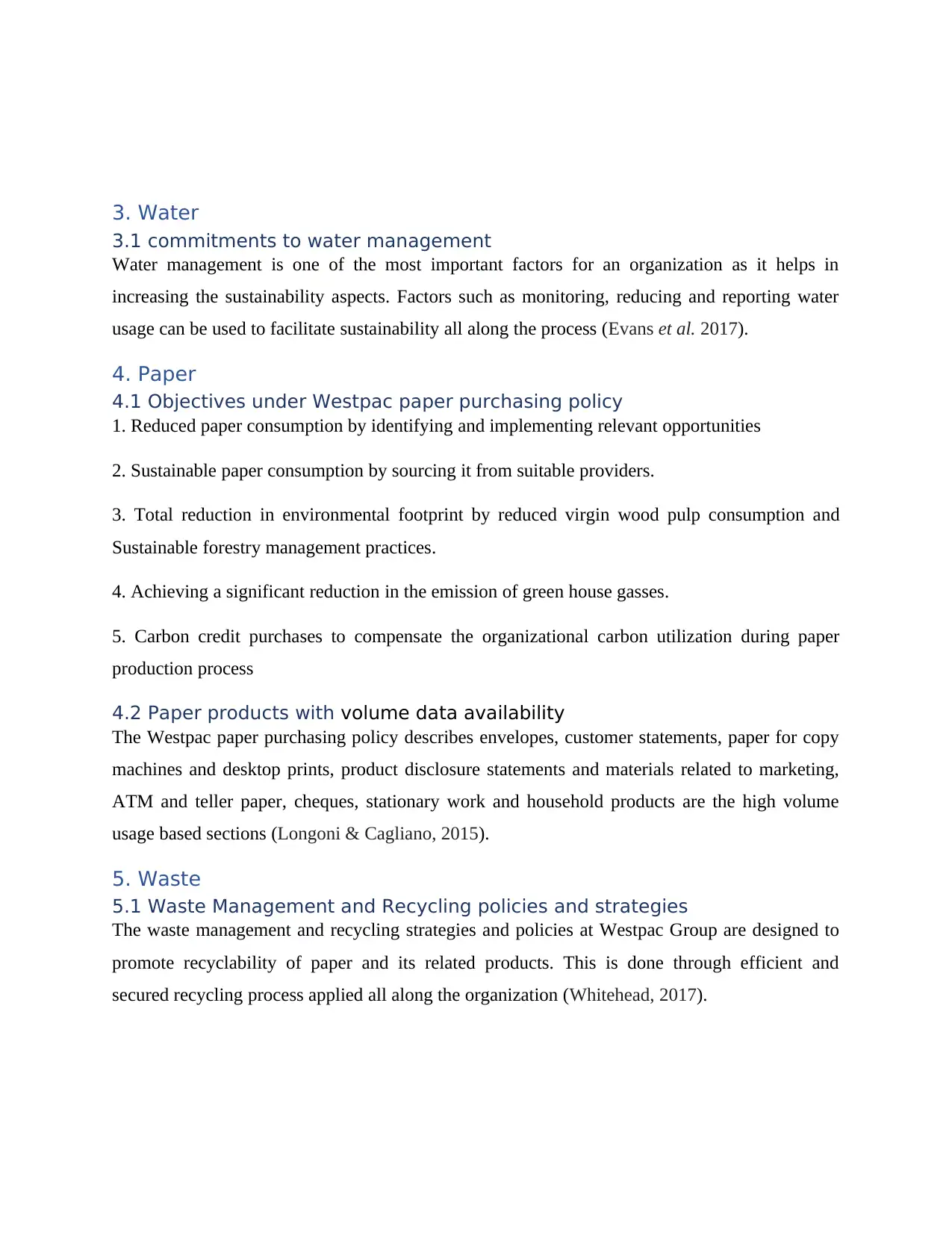
3. Water
3.1 commitments to water management
Water management is one of the most important factors for an organization as it helps in
increasing the sustainability aspects. Factors such as monitoring, reducing and reporting water
usage can be used to facilitate sustainability all along the process (Evans et al. 2017).
4. Paper
4.1 Objectives under Westpac paper purchasing policy
1. Reduced paper consumption by identifying and implementing relevant opportunities
2. Sustainable paper consumption by sourcing it from suitable providers.
3. Total reduction in environmental footprint by reduced virgin wood pulp consumption and
Sustainable forestry management practices.
4. Achieving a significant reduction in the emission of green house gasses.
5. Carbon credit purchases to compensate the organizational carbon utilization during paper
production process
4.2 Paper products with volume data availability
The Westpac paper purchasing policy describes envelopes, customer statements, paper for copy
machines and desktop prints, product disclosure statements and materials related to marketing,
ATM and teller paper, cheques, stationary work and household products are the high volume
usage based sections (Longoni & Cagliano, 2015).
5. Waste
5.1 Waste Management and Recycling policies and strategies
The waste management and recycling strategies and policies at Westpac Group are designed to
promote recyclability of paper and its related products. This is done through efficient and
secured recycling process applied all along the organization (Whitehead, 2017).
3.1 commitments to water management
Water management is one of the most important factors for an organization as it helps in
increasing the sustainability aspects. Factors such as monitoring, reducing and reporting water
usage can be used to facilitate sustainability all along the process (Evans et al. 2017).
4. Paper
4.1 Objectives under Westpac paper purchasing policy
1. Reduced paper consumption by identifying and implementing relevant opportunities
2. Sustainable paper consumption by sourcing it from suitable providers.
3. Total reduction in environmental footprint by reduced virgin wood pulp consumption and
Sustainable forestry management practices.
4. Achieving a significant reduction in the emission of green house gasses.
5. Carbon credit purchases to compensate the organizational carbon utilization during paper
production process
4.2 Paper products with volume data availability
The Westpac paper purchasing policy describes envelopes, customer statements, paper for copy
machines and desktop prints, product disclosure statements and materials related to marketing,
ATM and teller paper, cheques, stationary work and household products are the high volume
usage based sections (Longoni & Cagliano, 2015).
5. Waste
5.1 Waste Management and Recycling policies and strategies
The waste management and recycling strategies and policies at Westpac Group are designed to
promote recyclability of paper and its related products. This is done through efficient and
secured recycling process applied all along the organization (Whitehead, 2017).
⊘ This is a preview!⊘
Do you want full access?
Subscribe today to unlock all pages.

Trusted by 1+ million students worldwide

6. Hazardous substances
6.1 identification of Hazardous substances
The documents at Westpac Group lack any specific document which can inform about some
hazardous substances across the organization.
7. Current sustainability practices
7.1 Climate solutions targets 2020
The company is targeted to have a $10 billion commitment to the climate change initiative by
2020.
8. Organisation policy framework
8.1 Affected policies
A new sustainable policy is liable to affect two major policies operational across the
organization. These are the Westpac environmental policy and the Westpac paper policy.
6.1 identification of Hazardous substances
The documents at Westpac Group lack any specific document which can inform about some
hazardous substances across the organization.
7. Current sustainability practices
7.1 Climate solutions targets 2020
The company is targeted to have a $10 billion commitment to the climate change initiative by
2020.
8. Organisation policy framework
8.1 Affected policies
A new sustainable policy is liable to affect two major policies operational across the
organization. These are the Westpac environmental policy and the Westpac paper policy.
Paraphrase This Document
Need a fresh take? Get an instant paraphrase of this document with our AI Paraphraser

Part B
Activity 1
1. Relevant Legislation, Regulations and/or Codes of Practice
Environmental protection and biodiversity conservation act 1999 and Victoria: environment
protection act 1970 are the two pieces of relevant legislations that are listed in this state.
2. Source/References
Following are the relevant sources and references which have been used to develop the policy.
2018 – 2020 Westpac Sustainability Strategy
2018 – 2020 Westpac Sustainability Strategy
Westpac Environmental Policy
Westpac Paper Purchasing Policy
2020 Westpac Climate Change and Action Plan
Westpac Principles for Doing Business
3. Policy Ownership
The general manager would be considered as the policy owner.
4. Introduction and Life Cycle Management Approach
Introduction
Introduction is the most initial stage for any sustainability based practice across the process of
development. It will include development of awareness among the available staffs. It will
enhance their individual contribution to the process and also establish better reach and
significance across the organization. Enabling willingness to contribute and enhance positive
contribution are the factors which enhance the entire process and affect sustainability inclusion
across the process (Rauch, Dallasega & Matt, 2016). It helps in guiding the whole process of
organizational management and aligns the information which is suitably placed to include better
results and attract more businesses for the respective organization. Areas such as training,
education and resource utilization are the key essentials which must be used to signify the
growth potential and sustain better reasonability all along the process of production in an
organisation (Formentini & Taticchi, 2016).
Activity 1
1. Relevant Legislation, Regulations and/or Codes of Practice
Environmental protection and biodiversity conservation act 1999 and Victoria: environment
protection act 1970 are the two pieces of relevant legislations that are listed in this state.
2. Source/References
Following are the relevant sources and references which have been used to develop the policy.
2018 – 2020 Westpac Sustainability Strategy
2018 – 2020 Westpac Sustainability Strategy
Westpac Environmental Policy
Westpac Paper Purchasing Policy
2020 Westpac Climate Change and Action Plan
Westpac Principles for Doing Business
3. Policy Ownership
The general manager would be considered as the policy owner.
4. Introduction and Life Cycle Management Approach
Introduction
Introduction is the most initial stage for any sustainability based practice across the process of
development. It will include development of awareness among the available staffs. It will
enhance their individual contribution to the process and also establish better reach and
significance across the organization. Enabling willingness to contribute and enhance positive
contribution are the factors which enhance the entire process and affect sustainability inclusion
across the process (Rauch, Dallasega & Matt, 2016). It helps in guiding the whole process of
organizational management and aligns the information which is suitably placed to include better
results and attract more businesses for the respective organization. Areas such as training,
education and resource utilization are the key essentials which must be used to signify the
growth potential and sustain better reasonability all along the process of production in an
organisation (Formentini & Taticchi, 2016).
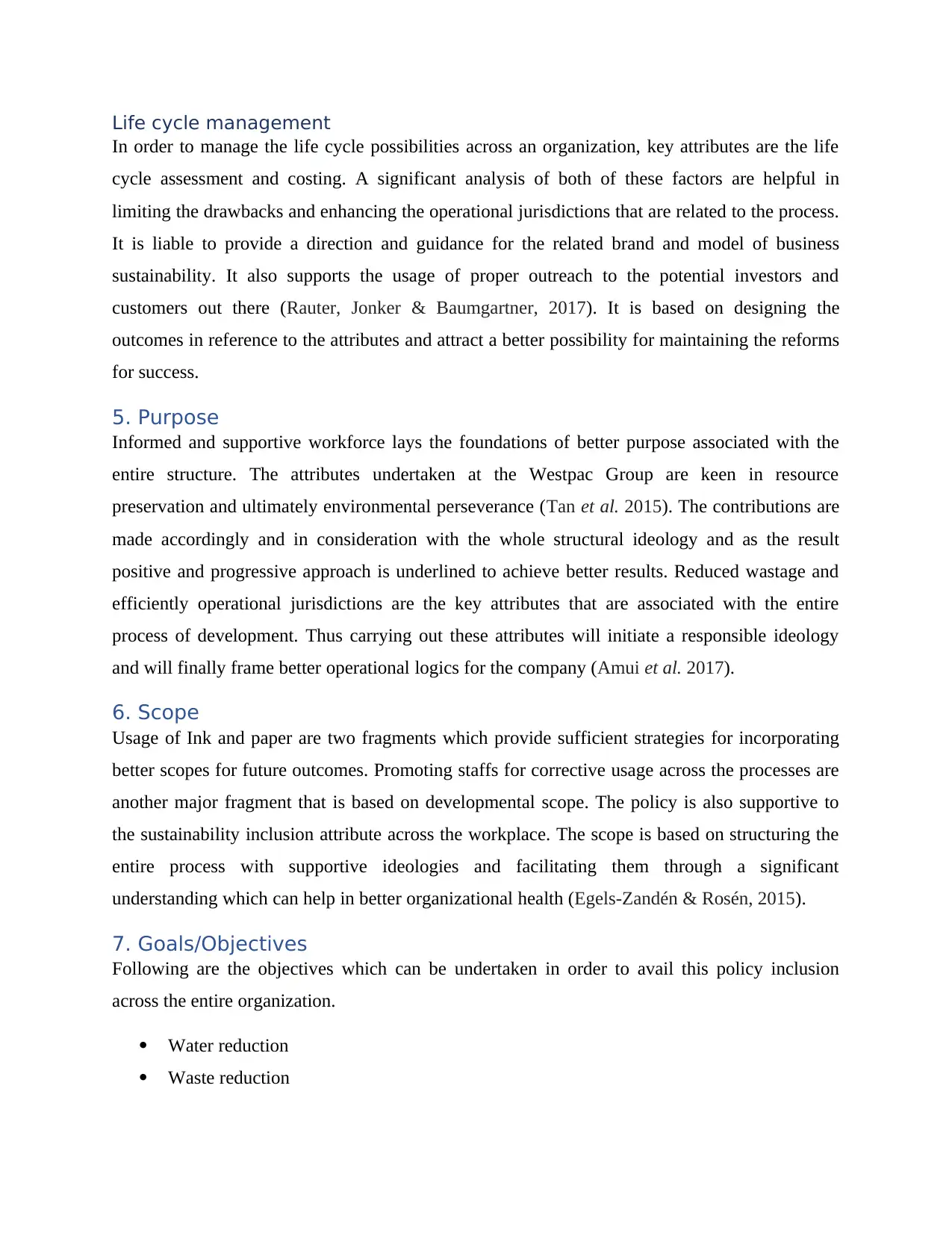
Life cycle management
In order to manage the life cycle possibilities across an organization, key attributes are the life
cycle assessment and costing. A significant analysis of both of these factors are helpful in
limiting the drawbacks and enhancing the operational jurisdictions that are related to the process.
It is liable to provide a direction and guidance for the related brand and model of business
sustainability. It also supports the usage of proper outreach to the potential investors and
customers out there (Rauter, Jonker & Baumgartner, 2017). It is based on designing the
outcomes in reference to the attributes and attract a better possibility for maintaining the reforms
for success.
5. Purpose
Informed and supportive workforce lays the foundations of better purpose associated with the
entire structure. The attributes undertaken at the Westpac Group are keen in resource
preservation and ultimately environmental perseverance (Tan et al. 2015). The contributions are
made accordingly and in consideration with the whole structural ideology and as the result
positive and progressive approach is underlined to achieve better results. Reduced wastage and
efficiently operational jurisdictions are the key attributes that are associated with the entire
process of development. Thus carrying out these attributes will initiate a responsible ideology
and will finally frame better operational logics for the company (Amui et al. 2017).
6. Scope
Usage of Ink and paper are two fragments which provide sufficient strategies for incorporating
better scopes for future outcomes. Promoting staffs for corrective usage across the processes are
another major fragment that is based on developmental scope. The policy is also supportive to
the sustainability inclusion attribute across the workplace. The scope is based on structuring the
entire process with supportive ideologies and facilitating them through a significant
understanding which can help in better organizational health (Egels-Zandén & Rosén, 2015).
7. Goals/Objectives
Following are the objectives which can be undertaken in order to avail this policy inclusion
across the entire organization.
Water reduction
Waste reduction
In order to manage the life cycle possibilities across an organization, key attributes are the life
cycle assessment and costing. A significant analysis of both of these factors are helpful in
limiting the drawbacks and enhancing the operational jurisdictions that are related to the process.
It is liable to provide a direction and guidance for the related brand and model of business
sustainability. It also supports the usage of proper outreach to the potential investors and
customers out there (Rauter, Jonker & Baumgartner, 2017). It is based on designing the
outcomes in reference to the attributes and attract a better possibility for maintaining the reforms
for success.
5. Purpose
Informed and supportive workforce lays the foundations of better purpose associated with the
entire structure. The attributes undertaken at the Westpac Group are keen in resource
preservation and ultimately environmental perseverance (Tan et al. 2015). The contributions are
made accordingly and in consideration with the whole structural ideology and as the result
positive and progressive approach is underlined to achieve better results. Reduced wastage and
efficiently operational jurisdictions are the key attributes that are associated with the entire
process of development. Thus carrying out these attributes will initiate a responsible ideology
and will finally frame better operational logics for the company (Amui et al. 2017).
6. Scope
Usage of Ink and paper are two fragments which provide sufficient strategies for incorporating
better scopes for future outcomes. Promoting staffs for corrective usage across the processes are
another major fragment that is based on developmental scope. The policy is also supportive to
the sustainability inclusion attribute across the workplace. The scope is based on structuring the
entire process with supportive ideologies and facilitating them through a significant
understanding which can help in better organizational health (Egels-Zandén & Rosén, 2015).
7. Goals/Objectives
Following are the objectives which can be undertaken in order to avail this policy inclusion
across the entire organization.
Water reduction
Waste reduction
⊘ This is a preview!⊘
Do you want full access?
Subscribe today to unlock all pages.

Trusted by 1+ million students worldwide
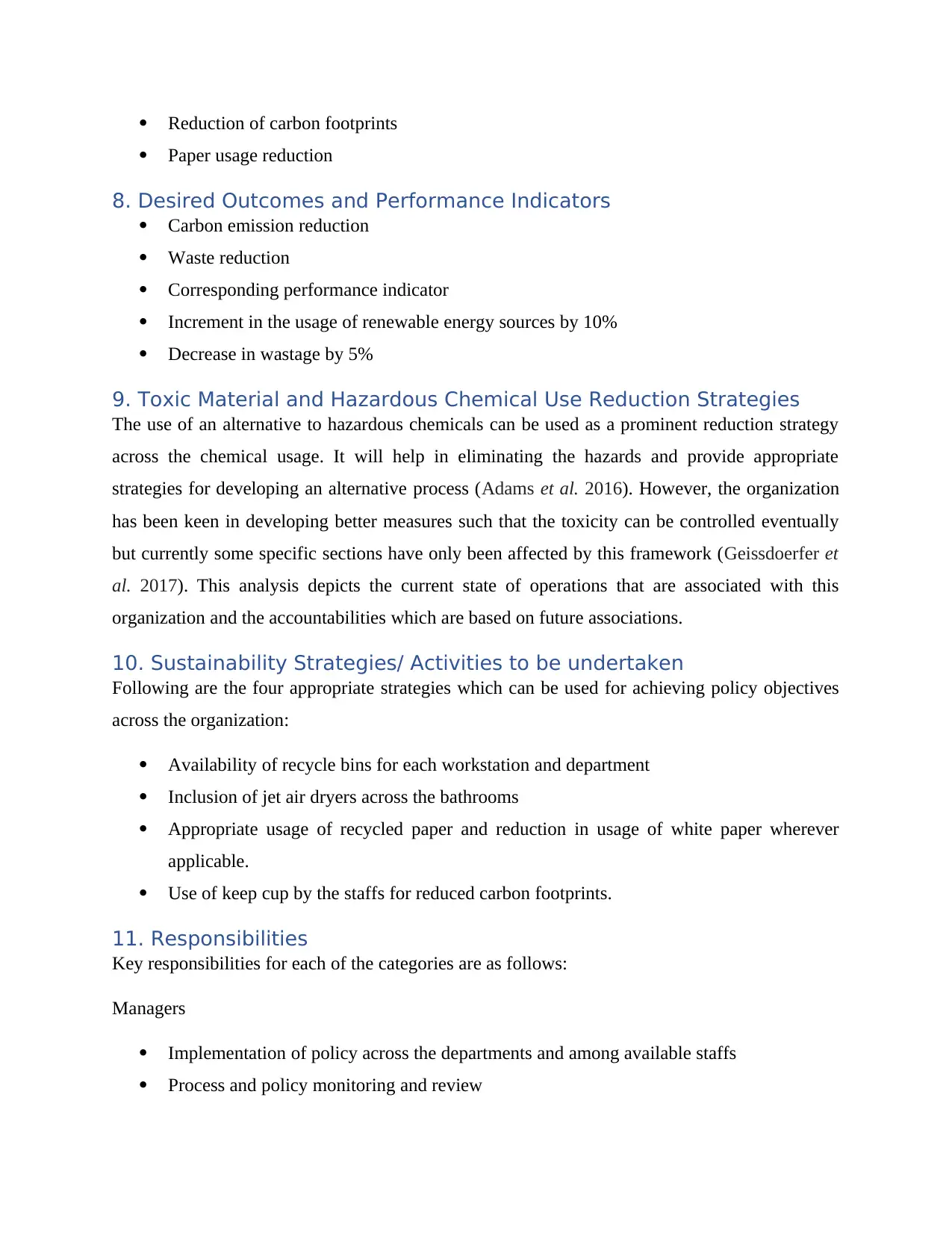
Reduction of carbon footprints
Paper usage reduction
8. Desired Outcomes and Performance Indicators
Carbon emission reduction
Waste reduction
Corresponding performance indicator
Increment in the usage of renewable energy sources by 10%
Decrease in wastage by 5%
9. Toxic Material and Hazardous Chemical Use Reduction Strategies
The use of an alternative to hazardous chemicals can be used as a prominent reduction strategy
across the chemical usage. It will help in eliminating the hazards and provide appropriate
strategies for developing an alternative process (Adams et al. 2016). However, the organization
has been keen in developing better measures such that the toxicity can be controlled eventually
but currently some specific sections have only been affected by this framework (Geissdoerfer et
al. 2017). This analysis depicts the current state of operations that are associated with this
organization and the accountabilities which are based on future associations.
10. Sustainability Strategies/ Activities to be undertaken
Following are the four appropriate strategies which can be used for achieving policy objectives
across the organization:
Availability of recycle bins for each workstation and department
Inclusion of jet air dryers across the bathrooms
Appropriate usage of recycled paper and reduction in usage of white paper wherever
applicable.
Use of keep cup by the staffs for reduced carbon footprints.
11. Responsibilities
Key responsibilities for each of the categories are as follows:
Managers
Implementation of policy across the departments and among available staffs
Process and policy monitoring and review
Paper usage reduction
8. Desired Outcomes and Performance Indicators
Carbon emission reduction
Waste reduction
Corresponding performance indicator
Increment in the usage of renewable energy sources by 10%
Decrease in wastage by 5%
9. Toxic Material and Hazardous Chemical Use Reduction Strategies
The use of an alternative to hazardous chemicals can be used as a prominent reduction strategy
across the chemical usage. It will help in eliminating the hazards and provide appropriate
strategies for developing an alternative process (Adams et al. 2016). However, the organization
has been keen in developing better measures such that the toxicity can be controlled eventually
but currently some specific sections have only been affected by this framework (Geissdoerfer et
al. 2017). This analysis depicts the current state of operations that are associated with this
organization and the accountabilities which are based on future associations.
10. Sustainability Strategies/ Activities to be undertaken
Following are the four appropriate strategies which can be used for achieving policy objectives
across the organization:
Availability of recycle bins for each workstation and department
Inclusion of jet air dryers across the bathrooms
Appropriate usage of recycled paper and reduction in usage of white paper wherever
applicable.
Use of keep cup by the staffs for reduced carbon footprints.
11. Responsibilities
Key responsibilities for each of the categories are as follows:
Managers
Implementation of policy across the departments and among available staffs
Process and policy monitoring and review
Paraphrase This Document
Need a fresh take? Get an instant paraphrase of this document with our AI Paraphraser
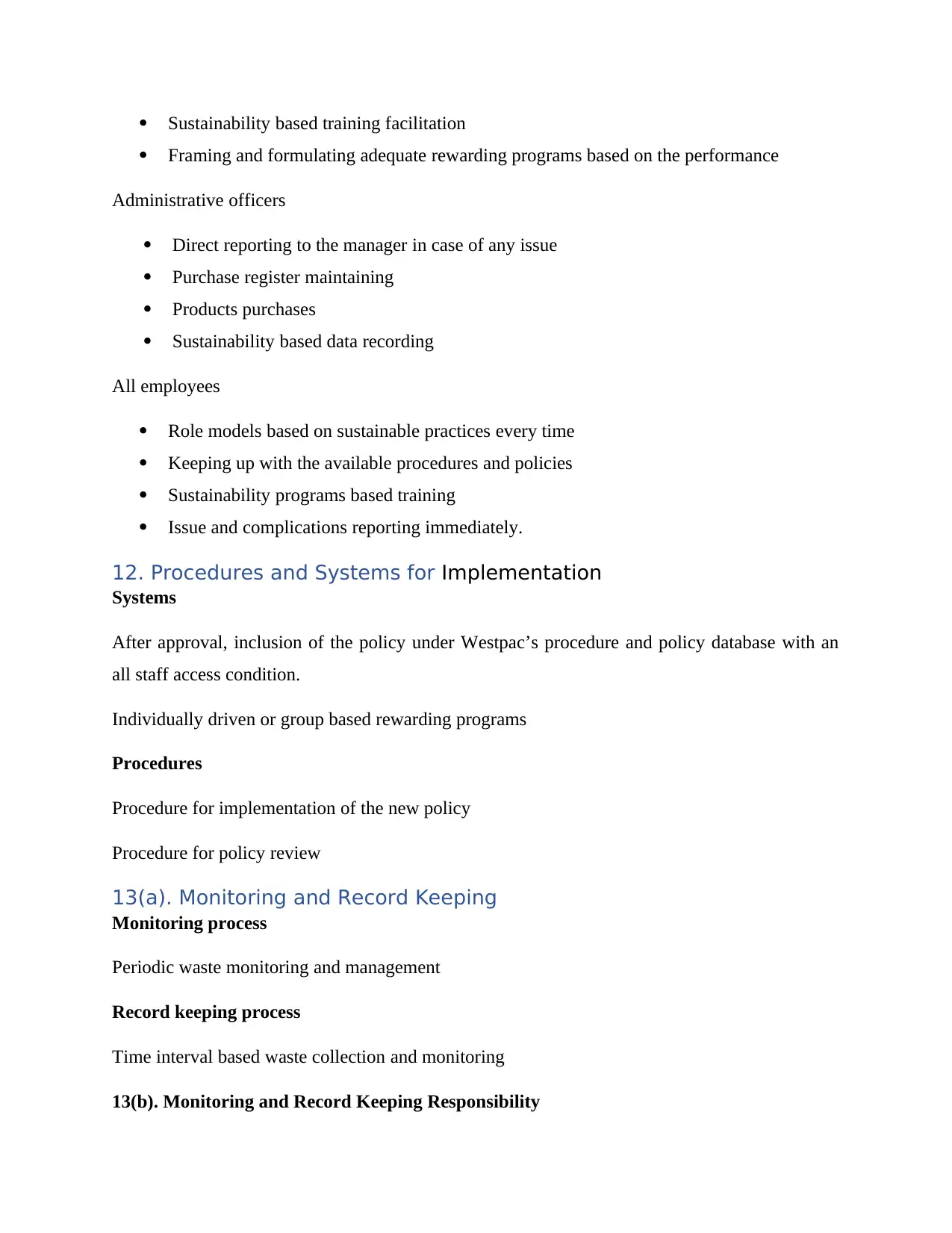
Sustainability based training facilitation
Framing and formulating adequate rewarding programs based on the performance
Administrative officers
Direct reporting to the manager in case of any issue
Purchase register maintaining
Products purchases
Sustainability based data recording
All employees
Role models based on sustainable practices every time
Keeping up with the available procedures and policies
Sustainability programs based training
Issue and complications reporting immediately.
12. Procedures and Systems for Implementation
Systems
After approval, inclusion of the policy under Westpac’s procedure and policy database with an
all staff access condition.
Individually driven or group based rewarding programs
Procedures
Procedure for implementation of the new policy
Procedure for policy review
13(a). Monitoring and Record Keeping
Monitoring process
Periodic waste monitoring and management
Record keeping process
Time interval based waste collection and monitoring
13(b). Monitoring and Record Keeping Responsibility
Framing and formulating adequate rewarding programs based on the performance
Administrative officers
Direct reporting to the manager in case of any issue
Purchase register maintaining
Products purchases
Sustainability based data recording
All employees
Role models based on sustainable practices every time
Keeping up with the available procedures and policies
Sustainability programs based training
Issue and complications reporting immediately.
12. Procedures and Systems for Implementation
Systems
After approval, inclusion of the policy under Westpac’s procedure and policy database with an
all staff access condition.
Individually driven or group based rewarding programs
Procedures
Procedure for implementation of the new policy
Procedure for policy review
13(a). Monitoring and Record Keeping
Monitoring process
Periodic waste monitoring and management
Record keeping process
Time interval based waste collection and monitoring
13(b). Monitoring and Record Keeping Responsibility
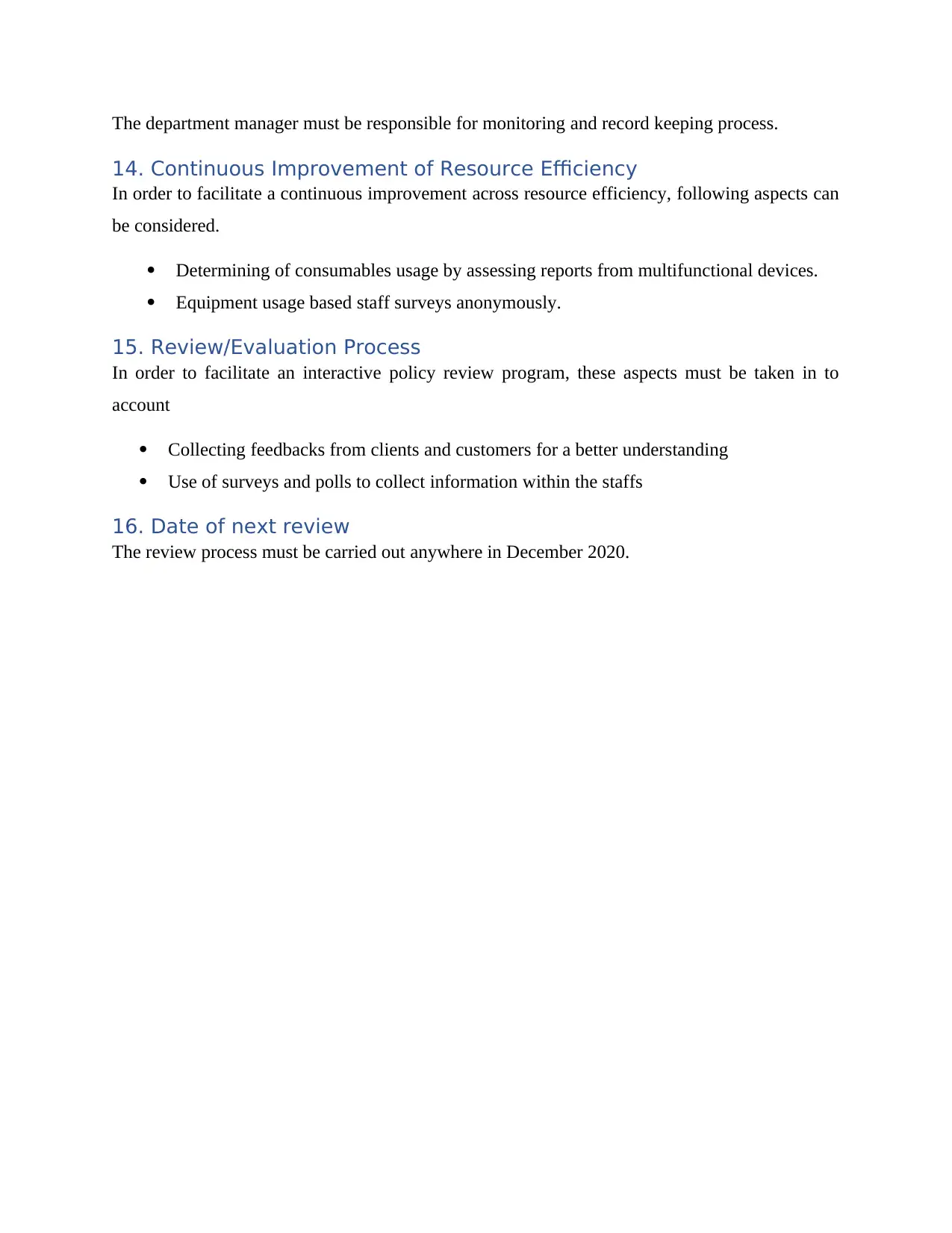
The department manager must be responsible for monitoring and record keeping process.
14. Continuous Improvement of Resource Efficiency
In order to facilitate a continuous improvement across resource efficiency, following aspects can
be considered.
Determining of consumables usage by assessing reports from multifunctional devices.
Equipment usage based staff surveys anonymously.
15. Review/Evaluation Process
In order to facilitate an interactive policy review program, these aspects must be taken in to
account
Collecting feedbacks from clients and customers for a better understanding
Use of surveys and polls to collect information within the staffs
16. Date of next review
The review process must be carried out anywhere in December 2020.
14. Continuous Improvement of Resource Efficiency
In order to facilitate a continuous improvement across resource efficiency, following aspects can
be considered.
Determining of consumables usage by assessing reports from multifunctional devices.
Equipment usage based staff surveys anonymously.
15. Review/Evaluation Process
In order to facilitate an interactive policy review program, these aspects must be taken in to
account
Collecting feedbacks from clients and customers for a better understanding
Use of surveys and polls to collect information within the staffs
16. Date of next review
The review process must be carried out anywhere in December 2020.
⊘ This is a preview!⊘
Do you want full access?
Subscribe today to unlock all pages.

Trusted by 1+ million students worldwide
1 out of 17
Related Documents
Your All-in-One AI-Powered Toolkit for Academic Success.
+13062052269
info@desklib.com
Available 24*7 on WhatsApp / Email
![[object Object]](/_next/static/media/star-bottom.7253800d.svg)
Unlock your academic potential
Copyright © 2020–2025 A2Z Services. All Rights Reserved. Developed and managed by ZUCOL.




